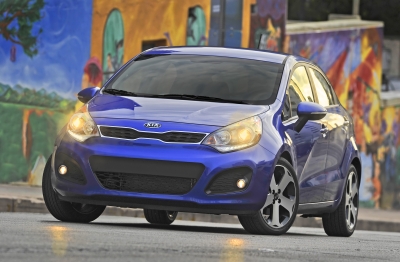What Is The Best Car Speaker Brand? Unlocking Your Vehicle’s Ultimate Audio Potential
What Is The Best Car Speaker Brand? Unlocking Your Vehicle’s Ultimate Audio Potential cars.truckstrend.com
The open road, a favorite playlist, and crystal-clear sound – for many, this is the epitome of driving pleasure. Yet, the factory-installed car audio system often falls short of delivering that immersive, high-fidelity experience. This leads countless enthusiasts and casual listeners alike to ponder a crucial question: "What is the best car speaker brand?"
The answer, however, is not a simple one-word declaration. The "best" car speaker brand isn’t a universal truth, but rather a subjective journey shaped by individual preferences, budget constraints, musical tastes, and the unique acoustics of a vehicle. It’s about finding the brand and specific speaker models that resonate most powerfully with your ears and your desired sound signature. This comprehensive guide will delve into the multifaceted world of car audio, helping you navigate the options and discover what truly constitutes the "best" for your personal sanctuary on wheels.
What Is The Best Car Speaker Brand? Unlocking Your Vehicle’s Ultimate Audio Potential
Understanding "Best": It’s Not One-Size-Fits-All
Before we dive into specific brands, it’s vital to understand why a singular "best" simply doesn’t exist. Car audio is a complex ecosystem, and the ideal speaker choice depends on several intertwined factors:
- Your Budget: Speaker prices can range from under $50 to several thousand dollars per pair. Setting a realistic budget is the first step in narrowing down your options.
- Your Musical Taste: Do you crave deep, thumping bass for hip-hop or electronic music? Or do you prefer crystal-clear vocals and intricate instrument separation for jazz, classical, or rock? Different brands excel in different sonic characteristics.
- Your Vehicle Type: The size and acoustic properties of your car (sedan, SUV, truck, convertible) significantly impact how speakers sound and what sizes will fit.
- Your Existing System: Are you replacing just the speakers, or are you upgrading the head unit, adding an amplifier, or even a subwoofer? The quality of your other components will influence the overall sound and what speaker characteristics you should prioritize.
- Desired Sound Signature: Some prefer a bright, airy sound, others a warm and rich tone, while some prioritize sheer loudness.

Ultimately, the "best" car speaker brand is the one that best meets your specific needs, budget, and auditory preferences, delivering an unparalleled listening experience tailored to you.
Key Factors to Consider When Choosing Car Speakers
To make an informed decision, you need to understand the technical aspects that define speaker performance.
-
Speaker Types:
- Coaxial (Full-Range) Speakers: These are the most common and easiest to install. They integrate all the speaker components (woofer, tweeter, and sometimes a mid-range driver) into a single basket. They are a good upgrade from factory speakers and offer a significant improvement in sound quality without complex installation.
- Component Speakers: These systems separate the woofer, tweeter, and a passive crossover network. The woofer handles low and mid-range frequencies, while the tweeter handles the highs. The external crossover ensures that each driver receives only the frequencies it’s designed to reproduce, leading to superior sound imaging, detail, and clarity, especially for critical listeners. They require more complex installation as the tweeters need to be mounted separately, often higher up in the car’s cabin (e.g., dashboard, A-pillars) for better staging.

-
Speaker Sizes:
Common sizes include 6.5-inch, 6×9-inch, 5.25-inch, and 6×8-inch. It’s crucial to check your car’s existing speaker sizes or consult your vehicle’s manual/online resources to ensure compatibility. While adapters can sometimes help fit slightly different sizes, sticking to the factory size simplifies installation. -
Power Handling (RMS vs. Peak):
- RMS (Root Mean Square) Power: This is the continuous power a speaker can handle reliably without damage. It’s the most important rating and should be matched closely with the RMS output of your amplifier (or head unit).
- Peak Power: This refers to the maximum power a speaker can handle for very short bursts. It’s less important for overall performance and often used for marketing. Always prioritize RMS.
-
Sensitivity:
Measured in decibels (dB), sensitivity indicates how efficiently a speaker converts power into sound. A higher sensitivity rating means the speaker will play louder with less power. If you’re running speakers off your factory head unit (which typically has low power output), look for speakers with higher sensitivity (e.g., 90dB and above). If you’re adding an external amplifier, sensitivity becomes less critical, allowing you to focus more on sound quality. -
Impedance:
Measured in ohms, impedance refers to the electrical resistance of the speaker. Most car speakers are 4 ohms. It’s important to match the speaker’s impedance with the output impedance of your amplifier or head unit to prevent damage and ensure optimal performance. -
Frequency Response:
This indicates the range of frequencies a speaker can reproduce, measured in Hertz (Hz). A wider frequency response (e.g., 20 Hz – 20,000 Hz) suggests a speaker can reproduce more of the audible spectrum, from deep bass to crisp highs. -
Material Quality:
- Cone Materials: Affect stiffness, weight, and damping. Common materials include polypropylene (durable, good all-rounder), woven glass fiber, carbon fiber (lightweight, rigid for accuracy), and paper (warm, natural sound, but less durable).
- Surround Materials: Connect the cone to the speaker basket and allow it to move. Rubber (butyl rubber) is durable and provides good excursion. Foam surrounds are lighter but less durable.
- Tweeter Materials: Silk (warm, smooth highs), aluminum or titanium (bright, detailed, sometimes harsh highs).

Top Contenders for "Best" Car Speaker Brands
While the ultimate "best" is subjective, certain brands consistently rise to the top, recognized for their innovation, build quality, and exceptional sound performance across various price points.
-
Focal:
- Strength: Audiophile-grade sound, unparalleled clarity, precise imaging, natural tonality.
- Description: A French brand renowned for high-end home and car audio. Focal speakers are meticulously engineered, offering incredibly detailed highs, rich midranges, and controlled bass. They are an investment but deliver an exquisite listening experience for discerning audiophiles.
-
JL Audio:
- Strength: Excellent bass response, balanced sound, robust build quality, great power handling.
- Description: A highly respected American brand, JL Audio excels in subwoofers but also produces exceptional full-range and component speakers. Their speakers are known for their ability to play loud and clear, with powerful, articulate bass that doesn’t overwhelm the rest of the sound spectrum.
-
Hertz:
- Strength: Italian craftsmanship, dynamic range, detailed highs, impactful mid-bass.
- Description: Part of the Elettromedia group, Hertz speakers are celebrated for their vibrant, dynamic sound and superb detail. They offer a lively presentation with excellent separation and clarity, making them a favorite among those who appreciate energetic and engaging sound.
-
Morel:
- Strength: Warm, natural sound signature, superb midrange reproduction, excellent imaging.
- Description: An Israeli company, Morel is celebrated for its handcrafted drivers and unique technologies. Their speakers produce a smooth, rich, and incredibly natural sound, particularly excelling in vocal reproduction and instrumental detail. They offer a refined, non-fatiguing listening experience.
-
Infinity / JBL (Harman Kardon Group):
- Strength: Excellent value, balanced sound, often bright and lively highs, good efficiency.
- Description: Both Infinity and JBL are part of the Harman International group, offering a wide range of speakers from entry-level to high-end. They consistently deliver strong performance for their price point, known for clear highs and a generally balanced sound, making them popular choices for direct factory replacements.
-
Pioneer / Kenwood / Sony:
- Strength: Mainstream accessibility, reliability, good value, solid entry-level options.
- Description: These Japanese electronics giants offer a vast array of car audio products. While they might not reach the audiophile heights of some specialized brands, they provide reliable, good-sounding speakers that are often excellent value for money, perfect for those looking for a significant upgrade from factory without breaking the bank.
-
Rockford Fosgate:
- Strength: Powerful, bass-heavy sound, high SPL (Sound Pressure Level) capability, durable.
- Description: An American brand known for its "Punch" series. Rockford Fosgate speakers are designed for those who want loud, impactful sound, especially strong bass. They are built tough and can handle significant power, making them a go-to for enthusiasts who prioritize volume and punch.
-
Kicker:
- Strength: Loud, dynamic, strong bass, good for high-volume listening.
- Description: Another American brand focused on delivering powerful sound. Kicker speakers are known for their efficiency and ability to play loud with authority. They are a popular choice for those who enjoy music with a strong beat and want to feel the bass.
-
Audison:
- Strength: Ultra-high-end, refined, detailed, exceptional sound staging.
- Description: An Italian brand, Audison represents the pinnacle of car audio. Their speakers, often paired with their equally impressive amplifiers, deliver a sophisticated, nuanced sound with incredible clarity and spatial accuracy. They are for the most demanding listeners willing to invest significantly in their audio experience.
How to Choose the Right Brand for YOU
- Define Your Budget: Be realistic. A $100 pair of speakers will offer a noticeable upgrade, but won’t compete with a $1000 component set.
- Identify Your Musical Preferences: Are you a bass-head or a clarity fanatic? This will guide you towards brands known for those characteristics.
- Assess Your Current Setup: Are you adding an amplifier? If not, prioritize high-sensitivity speakers. If you have an amp, you have more flexibility.
- Consider DIY vs. Professional Installation: Component speakers offer better sound but are harder to install. Coaxials are simpler. Factor in installation costs if you’re not doing it yourself.
- Read Reviews and Listen to Demos: While online reviews are helpful, try to listen to speakers in person if possible. Many car audio shops have demo boards. What sounds good to one person might not to another.
- Don’t Forget the Amplifier and Sound Deadening: Even the best speakers will sound mediocre without sufficient power and proper acoustic environment. An amplifier unlocks a speaker’s full potential, and sound deadening materials (like Dynamat) in your doors and trunk significantly reduce road noise and improve mid-bass performance.
Installation Tips and Challenges
- Measure First: Always confirm speaker sizes before purchasing.
- Wiring: Use good quality speaker wire. Ensure correct polarity.
- Sound Deadening: Highly recommended for all speaker upgrades. It reduces vibrations, road noise, and greatly improves mid-bass response and overall clarity. Apply it to the inner and outer door panels.
- Professional Installation: For component systems, or if you’re uncomfortable with car electrical work and panel removal, a professional installer can ensure optimal performance and avoid potential damage. Challenges include routing wires, finding proper mounting locations for tweeters and crossovers, and securely fastening speakers.
Table: Typical Price Ranges for Top Car Speaker Brands (Per Pair)
| Brand | Key Strength | Typical Coaxial Price Range (USD) | Typical Component Price Range (USD) |
|---|---|---|---|
| Focal | Audiophile clarity, precise imaging | $150 – $500 | $300 – $2000+ |
| JL Audio | Excellent bass, balanced, robust | $100 – $400 | $250 – $1500+ |
| Hertz | Dynamic range, detailed, impactful | $100 – $450 | $200 – $1800+ |
| Morel | Warm, natural sound, superb midrange | $120 – $500 | $280 – $2000+ |
| Infinity/JBL | Good value, balanced, bright highs | $50 – $250 | $100 – $500 |
| Pioneer | Reliable, good entry-level value | $40 – $200 | $80 – $400 |
| Kenwood | Reliable, good entry-level value | $40 – $200 | $80 – $400 |
| Sony | Entry-level accessibility, basic upgrade | $30 – $150 | $70 – $300 |
| Rockford F. | Powerful, bass-heavy, high SPL | $80 – $350 | $150 – $800 |
| Kicker | Loud, dynamic, strong bass | $70 – $300 | $120 – $700 |
| Audison | Ultra-high-end, refined, detailed | N/A (Focus on Components) | $500 – $3000+ |
Note: Prices are approximate and can vary significantly based on specific model, retailer, sales, and regional differences.
Frequently Asked Questions (FAQ)
Q1: Do I need an amplifier for aftermarket speakers?
A1: Not always, but highly recommended. Factory head units often provide 15-20 watts RMS per channel, which is enough for basic aftermarket speakers. However, to truly unlock the potential of mid-range to high-end speakers, an external amplifier is crucial. It provides cleaner, more powerful sound, reduces distortion at higher volumes, and allows speakers to perform at their best.
Q2: What’s the difference between coaxial and component speakers?
A2: Coaxial (full-range) speakers have all drivers (woofer, tweeter) integrated into one unit, making them easy to install. Component speakers separate the woofer, tweeter, and a crossover network, allowing for superior sound staging, imaging, and overall fidelity as each driver is optimally placed and receives specific frequencies.
Q3: Are more expensive speakers always better?
A3: Generally, yes, up to a certain point. Higher price usually means better materials, more advanced engineering, and superior sound quality. However, there are diminishing returns. A $1000 speaker set might be significantly better than a $200 set, but a $2000 set might only offer a subtle improvement over the $1000 set to the average listener. Your personal "best" depends on your ear and budget.
Q4: Can I install car speakers myself?
A4: Yes, coaxial speaker installation is a common DIY project for those with basic tools and some mechanical aptitude. Component systems are more complex due to separate tweeter mounting and crossover wiring. Many online tutorials and vehicle-specific guides are available. However, if unsure, professional installation is always a safe bet.
Q5: What is sound deadening and why is it important?
A5: Sound deadening involves applying specialized materials (like butyl rubber mats with aluminum backing) to car panels, especially inside doors. It reduces road noise, stops vibrations, and significantly improves the acoustic environment for your speakers. This leads to tighter bass, clearer midrange, and a more immersive listening experience. It’s often considered as important as the speakers themselves for optimal sound quality.
Q6: How do I know what size speakers my car needs?
A6: The easiest way is to check your car’s owner’s manual, or consult online resources like Crutchfield’s vehicle fit guide (which allows you to input your car’s make, model, and year to see compatible speakers). You can also physically measure your existing speakers, though this requires removing the door panels.
Conclusion
The quest for "What is the best car speaker brand?" is a personal journey, not a destination with a single answer. While brands like Focal, JL Audio, Hertz, and Morel consistently stand out for their exceptional quality and performance, the ultimate "best" is the brand and speaker model that aligns perfectly with your specific auditory preferences, vehicle, and budget.
By understanding key speaker characteristics, researching reputable brands, and considering the importance of proper installation and system integration (like adding an amplifier and sound deadening), you can transform your vehicle’s audio system from a mere sound producer into a concert hall on wheels. Embrace the journey, trust your ears, and enjoy the ultimate driving soundtrack.





